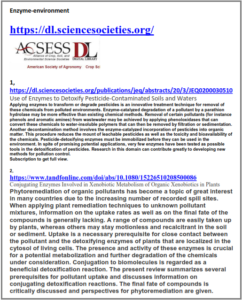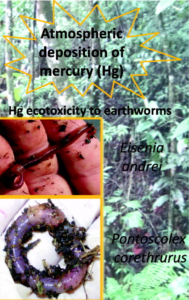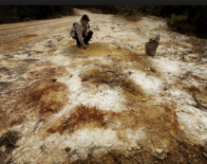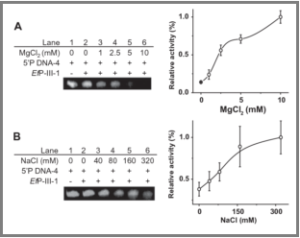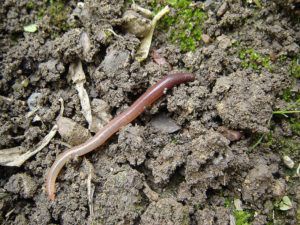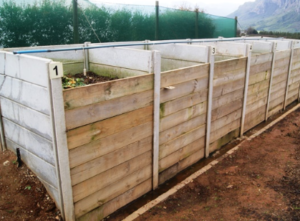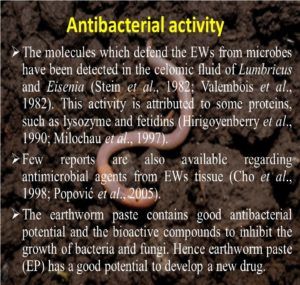Scientific Researches
Earthworms and Enzyme Research Studies
There are thousands of scientific research studies and publications available on the internet and other scientific information sources.
Scientists and biologists typically share the same opinion: when searching for solutions to toxification problems caused by human activity, wherein the earthworms are a hidden treasure in regards to providing directions leading to the solutions. Clicking on the picture on the left, there is a summary of 58 scientific research, a wide range of collected documents regarding detoxification, decontamination benefits of using enzymes in the environment. Having the earthworms’ liquid enzyme formula means having the best, most effective organic enzyme on Earth.
Below you will find more examples of such research.
Removal of hazardous material containing high concentrations of heavy metal
Researchers in South America have studied the viability of using earthworms to process hazardous material containing high concentrations of heavy metal for the bioremediation of old industrial sites, landfill and other potentially hazardous areas.
The team has carried out two feasibility studies on the use of worms in treating waste. The team first used compost produced by worms, vermicompost, as a successful adsorbent substrate for remediation of wastewater contaminated with the metals nickel, chromium, vanadium and lead. The second used earthworms directly for remediation of arsenic and mercury present in landfill soils and demonstrated an efficiency of 42 to 72% in approximately two weeks for arsenic removal and 7.5 to 30.2% for mercury removal in the same time period. Earthworms could offer an inexpensive and effective bioremediation alternative to complex and costly industrial cleanup methods, the team suggests. Given that the accumulation of solid wastes in landfills causes high risk for soils, underground and surface water contamination, so an effective remediation method is increasingly important as toxic metals in a wide range of waste products from obsolete computers to portable electronic devices are discarded in landfill
Removal of toxins and pesticides from polluted environments with enzymes
Applying enzymes to transform or degrade pesticides is an innovative treatment technique for removal of these chemicals from polluted environments. Enzyme-catalyzed degradation of a pollutant by a parathion
hydrolase may be more effective than existing chemical methods. Removal of certain pollutants (for instance phenols and aromatic amines) from wastewater may be achieved by applying phenoloxidases that can convert these chemicals to water-insoluble polymers that can then be removed by filtration or sedimentation.
Another decontamination method involves the enzyme-catalyzed incorporation of pesticides into organic matter. This procedure reduces the mount of leachable pesticides as well as the toxicity and bioavailability of the chemicals.
Purification of Enzymes from Earthworms
A lot of useful enzymes can be purified directly from earthworms homogenates, mainly by chromatographic techniques. Enzymes used in human therapeutics such as EFE’s need to be extensively purified while those utilized for other applications such as soil bioremediation can be only isolated by precipitation.
In conclusion, earthworms are an endless source of enzymes useful for different applications and the specific protocol for their purification will depend upon the requirement of the final product to be obtained.
The key to success has been that the worms burrow up to five feet deep into the contaminated soil, soak up heavy metals and other toxins, and then come to the surface without releasing the toxins.
The worms then are allowed to wander off into nearby land, dispersing and diluting the toxins so they no longer pose a threat to people or the environment. Otherwise, the worms may be transported to a secure, long term dump site or burned in an incinerator. Already a pilot project has shown a drastic reduction in toxicity after the worms, bought for $20 per kilogram from a commercial grower about 100 miles from the toxic site, were spread over polluted earth near the industrial city of Ahmedabad.
Scientists have discovered how metal-munching earthworms can help plants to clean up contaminated soils.
Earthworms could be the future “21st Century eco-warriors”, scientists suggested at the British Association Science Festival in Liverpool.
Earthworms are ideal “soil detectives”: their presence can act as a reliable indicator to the general health of the soil. They have evolved a mechanism that allows them to survive in soils contaminated with toxic metals including arsenic, lead, copper and zinc.
British scientists have cracked the global earthworm mystery: they have worked out how the planet’s great subterranean reprocessing system copes with the poisons that would choke most herbivores. Earthworms seem to have the stomach for almost anything vegetable. And Manuel Liebeke and Jakob Bundy of Imperial College in London have the answer. They and colleagues report in the journal Nature Communications that that the earthworm’s gut contains a suit of molecules that neutralise the polyphenols that give plants their colour, serve as antioxidants and discourage many ravenous grazers.
Applied and Environmental Soil Science Volume 2010, Article ID 294258. Earthworm proteases have been applied in several areas such as clinical treatment of clotting diseases, anti-tumor study, environmental protection and nutritional production. The current clinical utilizations and some potential new applications of the earthworm protease will be discussed in this study.
Conclusion:
Earthworm proteases are getting more significant in our daily life nowadays. It is applicable in both experiment and production, such as medical usage, environmental protection, and nutritional production. In the near future, more products based on the earthworm protease will reach the market.
Journal of Chemical and Pharmaceutical Research
Earthworm plays a major role in the proper functioning of the soil ecosystem.
Earthworms have been used in medicine for various remedies since 1340 AD [1]. Earthworm has been recognized in oriental medicine as anti- inflammatory, analgesic and antipyretic agent [2].
It shows anticancer effect by preventing excess glucose uptake [3]. Microorganisms are known to play a major role in soil characteristics, invertebrates are believed to act as regulators of antimicrobial activity. Earthworm surface excreta were found to have potent antimicrobial
activity [4]. It is also having anticoagulatory or fibrinolytic activity which results in the facilitation of blood circulation [5]. The earthworm has been suspected to contain proteases which dissolve the fibrin clots or anticoagulants which selectively interfere with the intrinsic pathway of blood coagulation cascade [6-10]. Medicinal properties of earthworm have been described [11-15]. Earthworms have largely been used internally and externally as powerful aphrodisiacs [16]. Anti-inflammatory activity of earthworm extracts was studied [17]. The antiinflammatory and antipyretic activities of biologically active extract isolated form whole earthworm, Lampito mauritii were determined [18].
A team of scientists at Reading University have discovered that earthworms may be helping plants to decontaminate soil polluted with various metals. Heavily industrialised areas of the UK played host to mines, lead smelters and engineering centres during the industrial age, which over the years have degraded the soil and infused it with toxic metals.
Earthworms are considered as soil engineers because of their effects on soil properties and their influence on the availability of resources for other organisms, including microorganisms and plants. However, the links between their impacts on the soil environment and the resulting modification of natural selection pressures on engineer as well as on other organisms have received little attention. Earthworms are known to have a positive influence on the soil fabric and on the decomposition and mineralization of litter by breaking down organic matter and producing large amounts of fasces, thereby mixing litter with the mineral soil.
Everyday earthworms are the latest solution to a thorny problem that most wine drinkers never consider: wastewater disposal.
This system is using nature. It’s using worms and microbes to treat all of our winery wastewater.
Sanjai Parikh, an associate professor of soil chemistry at the University of California, Davis, says BioFiltro looks like a promising option for treating winery wastewater.
“That type of approach of recreating the natural system in this contained environment, I think, is a very good approach and could be really beneficial. It’s something that wineries and tomato canneries and similar facilities should all consider,” Parikh says.
The quoted results imply that earthworms, or the products of their metabolism, applied in the certain concentrations, could decrease the growth of the facultative-pathogenic bacteria and thus may promote growth of non-pathogenic agriculturally useful bacteria, such as Bradyrhizobium japonicum, Rhizobium leguminosarum, Azotobacter chroococcum.
Parenteral administration of the protein antigen to earthworms induces elevated levels of antigen-binding proteins (ABP), which recognized the protein used for stimulation.
The molecular masses of these ABP were 56 kDa in Lumbricus terrestris and 60 kDa in Eisenia foetida (HANUSOVA et al., 1999b; KOHLEROVA et al., 1999). A protein of 60 kDa was identified as a ubiquitous PLA2-like enzyme, which might be involved in the immune reaction of earthworms, such as anti-bacterial mechanisms (HANUSOVA et al., 1999a).
The burrowing and casting activities of earthworms contribute to the activity of soil micro organisms and nutrient enriched earthworm casts are good media supporting microbial growth.
The microbial community in the gut of earthworms was predominantly Gram-negative bacteria. The present study reported that vermicompost
is rich in microbial populations and diversity, particularly fungi and bacteria. It is possible that earthworms can be used not only in environmental monitoring, but also in the acquisition of novel molecules for human therapeutic purposes. This study may thus lead to formulation of new natural antimicrobial agent and thus may be found to be beneficial in future prospects for mankind.
Coelomic fluid of the earthworm, Eisenia fetida andrei, naturally inhibits the in vitro growth of the two worm pathogen bacteria, Aeromonas hydrophila (Gram-negative) and Bacillus megaterium (Gram-positive). LD50 values (injected dose causing death of 50% of the worm population) indicated that E. fetida andrei is more susceptible to A. hydrophila (5 × 103living bacteria) than to B. megaterium (5 × 105). One injection of LD50 resulted in an increased humoral bacteriostatic activity peaking 4 days after injection. Such enhanced activity totally protected the worms against infestation with 200 to 2000 times the LD50 dose and persisted for 4 days with A. hydrophila and 11 days with B. megaterium. Secondary response, different from the first one, was obtained on animals reinjected with the LD50 dose at the time when normal bacteriostatic activity was recovered (respectively 15 and 22 days after the first injection) but not 15 days later.
One Ayurvedic theory asserts that each human possesses a unique combination of dosas that define that person’s temperament and characteristics [42–44]. Another view, also present in the ancient literature, asserts that humoral equality is identical to health, and those persons with preponderances of humour are proportionately unhealthy, and not their natural temperament. In this current paper, emphasis will be placed on the whole animal, the laboratory rat. Various functions are modified by using extracts and/or paste derived from earthworms to ameliorate certain experimental inflammatory responses.
Worms produce unique and potent molecules. Lumbrokinase (LK) is a group of six, novel proteolytic enzymes derived from the earthworm Lumbricus rubellas. In a 1992 study, a crude extract of the worm was shown to have a potent thrombolytic effect.
Human Studies Demonstrate Potency and Efficacy. Clinical trials in humans have been equally impressive.
As a traditional Chinese medicine (TCM), earthworm (Dilong) was applied in China for ages. Some active proteins and compounds in earthworm were characteristic composition as a pharmaceutical, including fibrinolytic enzymes, lumbrokinase, collagenase, superoxide dismutase, cholinesterase, catalases, glycosidases, metallothionein, calmodulin-binding protein, proteins with proliferation improving activity, lysenin, eiseniapore, antitumor protein, glycoprotein extract, gut mobility regulation peptide, antibacterial peptide, carbamidine, lumbritin, lumbrofobrim, terrestrolumbrolysin, purin, vitamin B, tyrosine, succinic acid, lauric acid, unsaturated fatty acid and so on. These earthworm components had more or less pharmacological and clinical functions on effects on the nervous system, blood system, the cardiovascular system, the respiratory system, uterus smooth muscle, and its anticancer function and sperm-killing function. Lumbricus metalchelatins (LMT) among these active components has detoxification function.
Earthworm castings are known to be a rich source of plant growth promoting substances viz., growth hormones, enzymes and vitamins (Karthikeyan et al.
AgroIndia 7:34–353, 2004). Earthworm castings also contains a number of beneficial microorganisms, nitrogen fixing, phosphorous solubilizing and cellulose decomposing organisms, which help in improving soil productivity.
Earthworms have an in-house supply of enzymes like Nitrate reductase, acid phosphatase and alkaline phosphatase, which are involved in the metabolism of nitrogen and phosphate materials present in the compost.
The earthworms speed up the composting process and transform wastes into nutrient rich castings with the help of the enzymes (Prabha et al. South Asian J Socio-Polit Stud 2:129–130–156, 2005).

